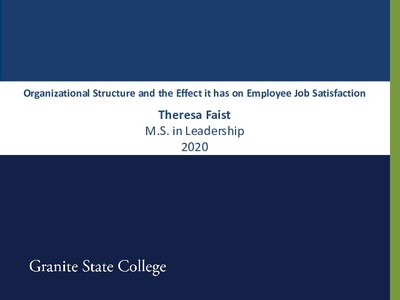Organizational structure and the effect it has on employee job satisfaction
Organizational structure and the effect it has on employee job satisfaction
| dc.contributor.author | Faist, Theresa | |
| dc.date.accessioned | 2022-01-05T14:36:39Z | |
| dc.date.available | 2022-01-05T14:36:39Z | |
| dc.date.semester | Spring 2020 | |
| dc.identifier.uri | https://archives.granite.edu/handle/20.500.12975/365 | |
| dc.description | Recruiting and retaining the right employee is an essential aspect of an organization's success. This quantitative study seeks to identify, through an anonymous voluntary survey, if there is a relationship between organizational structure and employee job satisfaction. The four most common organizational structures: functional, divisional, matrix, and flatarchy were measured against the nine dimensions in Spector's Job Satisfaction Survey OSS): pay, promotion opportunities, supervision, fringe benefits, contingent rewards, operating procedures, coworkers, nature of work, and communication. This study takes a close look at how each organizational structure relates to employee job satisfaction. Quite interestingly, the results from this study show no significant difference in overall employee job satisfaction across three of the four organizational structures reported and analyzed. Based on the results of this study it is suggested that studies continue to take place with a focus on leadership style in relationship to employee job satisfaction. | |
| dc.title | Organizational structure and the effect it has on employee job satisfaction | |
| dc.title | Organizational structure and the effect it has on employee job satisfaction |


